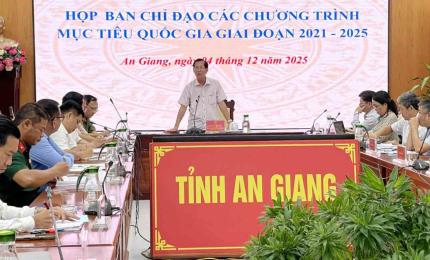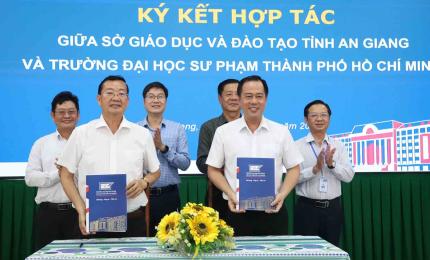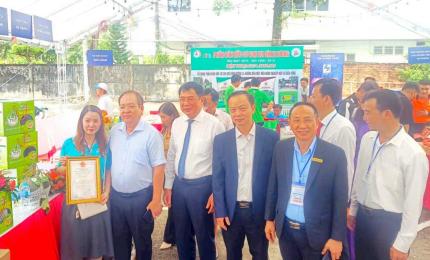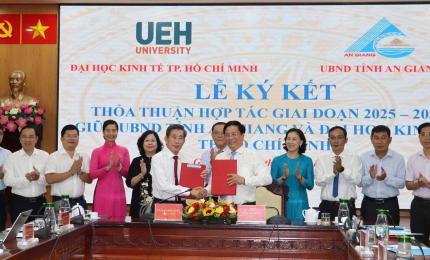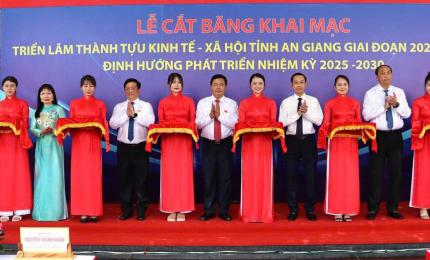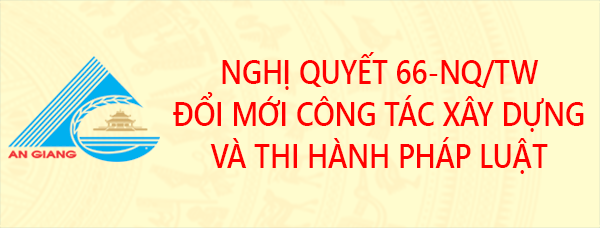(AG Provincial E-Portal) - With outstanding advantages in geographical location, diverse economic potential, rich cultural identity, and abundant social resources, the merger of An Giang and Kien Giang provinces promises to form a new economic growth pole for the Mekong Delta.
When these two high-potential localities officially unify, a new administrative entity of exceptional scale and strength will emerge. The newly formed An Giang Province will possess consolidated advantages, paving the way for prosperity and progress for the region and its people.
A Launchpad for Growth
An Giang and Kien Giang boast strategic geographic locations. An Giang borders Cambodia and serves as a crucial international trade gateway. In 2024, its total export turnover through border gates reached USD 1.22 billion, reflecting its immense potential in market expansion and investment attraction. The province is one of Vietnam’s largest rice producers, with over 650,000 hectares of rice cultivation and an annual output of more than 4 million tons. It also has significant potential in industrial crops, fruit trees, and freshwater aquaculture—with aquaculture covering 2,010 hectares and producing nearly 701,000 tons in 2024.

Meanwhile, Kien Giang’s 200-kilometer coastline and extensive island system—including Phu Quoc, Nam Du, and Tho Chu—give it a competitive edge in marine economics, particularly in aquaculture and fisheries. In 2024, the province harvested 4.7 million tons of rice and nearly 815,000 tons of seafood. It is also emerging as a hub for renewable energy, especially wind and solar power. An Giang is known for its deep cultural heritage, historical sites, and festivals rooted in Kinh, Khmer, Cham, and Hoa traditions. Kien Giang contributes a distinctive maritime culture, highlighted by the “Nghinh Ong” Festival, traditional craft villages, and regional cuisine. The cultural diversity of both provinces holds immense value for developing tourism focused on heritage, history, and spirituality.
A Synergistic Union
Beyond a geographical and administrative merger, this unification is expected to form a powerful socio-economic entity, unlocking potential and creating a new growth engine for the Mekong Delta. The new An Giang will be among the region’s largest provinces, with a total area of nearly 9,900 km², a population of over 4.95 million, and 102 communes, wards, and special administrative zones. This larger administrative scale will enable comprehensive planning and synchronized development policies.

Notably, with An Giang’s strong potential in border trade and Kien Giang’s advantage in marine economy and island tourism, the newly formed An Giang Province has a solid foundation to propose the establishment of one or more coastal economic zones or key border economic zones. These special zones would benefit from preferential mechanisms and policies, attracting both domestic and foreign investment in fields such as high technology, logistics, deep processing, and integrated tourism—thus creating new momentum for regional development.
The merger of An Giang and Kien Giang brings forth a promising and diverse economic landscape. In the realm of high-tech agriculture and deep processing, An Giang continues to assert its position as a leading agricultural production hub with vast areas of high-quality rice, specialty fruits, and strong potential in freshwater aquaculture.
Connecting with Kien Giang—known for its strengths in seafood processing and exports—will enable the creation of a robust value chain from raw material production to processing and market distribution, thereby increasing the added value of regional agricultural products. With its large volumes of rice and seafood, the new An Giang Province has the potential to become the region’s largest center for agricultural and aquacultural processing, oriented toward the export of high-value products.

With a strategic geographical location and key international border gates such as Tinh Bien and Ha Tien, the new province presents significant opportunities for the development of cross-border trade and logistics services. Its integration with Kien Giang’s seaport network will form an efficient economic corridor, reducing transport costs and boosting trade with ASEAN countries and the broader Mekong subregion. In 2024, the combined export turnover through the border gates of An Giang and Kien Giang exceeded USD 2.3 billion—underscoring strong growth potential.In the field of renewable energy and green economy, both An Giang and Kien Giang possess significant potential for solar and wind power development. The merger will create favorable conditions for the planning and implementation of large-scale renewable energy projects, providing clean energy to support economic growth and contribute to environmental protection.

In addition, An Giang is home to renowned spiritual tourism sites such as the Ba Chua Xu Shrine on Sam Mountain and the Cam Mountain Tourist Area, which attract millions of visitors annually. Meanwhile, Kien Giang, with its long coastline and island gems like Phu Quoc and Nam Du, is one of the country’s premier beach tourism destinations.
In 2024, An Giang welcomed 9.1 million visitors, including 25,000 international tourists, generating VND 10,250 billion in tourism revenue. As Vietnam’s leading coastal and island tourism center, Kien Giang received nearly 10 million visitors, including approximately 980,000 international tourists, with tourism revenue exceeding VND 25,100 billion.These figures reflect the immense tourism potential of the newly formed An Giang Province.
Following the merger, the total number of visitors could exceed 20 million annually, with projected tourism revenue reaching VND 35,350 billion—positioning the new province as a major tourism growth pole for the region. The diversity of tourism offerings, ranging from cultural and spiritual tourism in An Giang to beach and island tourism in Kien Giang, will attract a wider range of visitors, extend their stays, and increase spending.With these advantages, the new An Giang Province holds strong potential to develop luxury resorts and high-end tourism services, attracting further investment in modern tourism infrastructure.
Prospects for a Prosperous An Giang Mr. Le Hong Quang, Member of the Party Central Committee and Secretary of the An Giang Provincial Party Committee, affirmed:“The policy of merging An Giang and Kien Giang is a far-reaching strategic decision that opens a new path for development. Each province has its own strengths that complement each other perfectly. The combination of An Giang’s solid agricultural foundation and spiritual tourism with Kien Giang’s economic potential and coastal tourism will create a powerful synergy. The unified An Giang Province will possess the resources and scale to implement breakthrough development projects—from connected transportation infrastructure to key economic zones—generating employment and increasing incomes for the people, propelling An Giang toward robust and sustainable growth.” |
Reported by Thu Thao
Translated by Kim Thuan
